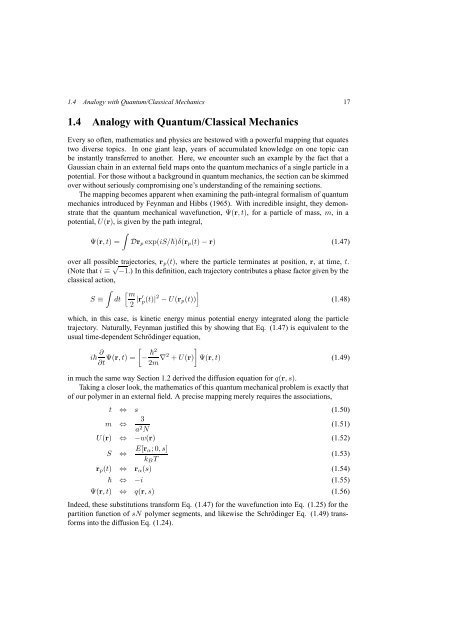Self-Consistent Field Theory and Its Applications by M. W. Matsen
Self-Consistent Field Theory and Its Applications by M. W. Matsen
Self-Consistent Field Theory and Its Applications by M. W. Matsen
Create successful ePaper yourself
Turn your PDF publications into a flip-book with our unique Google optimized e-Paper software.
1.4 Analogy with Quantum/Classical Mechanics 17<br />
1.4 Analogy with Quantum/Classical Mechanics<br />
Every so often, mathematics <strong>and</strong> physics are bestowed with a powerful mapping that equates<br />
two diverse topics. In one giant leap, years of accumulated knowledge on one topic can<br />
be instantly transferred to another. Here, we encounter such an example <strong>by</strong> the fact that a<br />
Gaussian chain in an external field maps onto the quantum mechanics of a single particle in a<br />
potential. For those without a background in quantum mechanics, the section can be skimmed<br />
over without seriously compromising one’s underst<strong>and</strong>ing of the remaining sections.<br />
The mapping becomes apparent when examining the path-integral formalism of quantum<br />
mechanics introduced <strong>by</strong> Feynman <strong>and</strong> Hibbs (1965). With incredible insight, they demonstrate<br />
that the quantum mechanical wavefunction, Ψ(r,t), for a particle of mass, m, ina<br />
potential, U(r), is given <strong>by</strong> the path integral,<br />
∫<br />
Ψ(r,t)= Dr p exp(iS/)δ(r p (t) − r) (1.47)<br />
over all possible trajectories, r p (t), where the particle terminates at position, r, at time, t.<br />
(Note that i ≡ √ −1.) In this definition, each trajectory contributes a phase factor given <strong>by</strong> the<br />
classical action,<br />
∫ [ m<br />
S ≡ dt<br />
2 |r′ p(t)| 2 − U(r p (t))]<br />
(1.48)<br />
which, in this case, is kinetic energy minus potential energy integrated along the particle<br />
trajectory. Naturally, Feynman justified this <strong>by</strong> showing that Eq. (1.47) is equivalent to the<br />
usual time-dependent Schrödinger equation,<br />
i ∂ [<br />
]<br />
∂t Ψ(r,t)= − 2<br />
2m ∇2 + U(r) Ψ(r,t) (1.49)<br />
in much the same way Section 1.2 derived the diffusion equation for q(r,s).<br />
Taking a closer look, the mathematics of this quantum mechanical problem is exactly that<br />
of our polymer in an external field. A precise mapping merely requires the associations,<br />
t ⇔ s (1.50)<br />
m ⇔ 3<br />
a 2 N<br />
(1.51)<br />
U(r) ⇔ −w(r) (1.52)<br />
S ⇔ E[r α;0,s]<br />
k B T<br />
(1.53)<br />
r p (t) ⇔ r α (s) (1.54)<br />
⇔ −i (1.55)<br />
Ψ(r,t) ⇔ q(r,s) (1.56)<br />
Indeed, these substitutions transform Eq. (1.47) for the wavefunction into Eq. (1.25) for the<br />
partition function of sN polymer segments, <strong>and</strong> likewise the Schrödinger Eq. (1.49) transforms<br />
into the diffusion Eq. (1.24).
















